Fast Facts
When was it built: 950-1050 CE
Who built it: Rulers of the Rajput Chandela Dynasty
Time taken to built: More than 100 years
Where is it located: Khajuraho, Chhatarpur district, Madhya Pradesh, India
Why was it built: Place of Hindu and Jain worship
Dimension: originally 85 temples over 21 square Km area; currently reduced to 25 temples over 6 square Km area
Materials Used in Construction: Granite or sandstone in shades of buff, pink and pale yellow
Architectural Style: Nagara
Visit Timing: Sunrise to Sunset
Maintained by: Archeological Survey of India
Entry Fee: An entry fee of Rs. 30 is charged for Indian Citizens while, visitors from foreign countries have to pay a sum of Rs. 500. Entry is free for children up to 15 years of age.
How to Reach: Khajuraho is easily accessible from all parts of India by Air as well as roads.
Air: Khajuraho has its own airport, located 5 Km from the city. Major airlines in India like Air India, Jet Airways and Indigo ply to and from major metros like Delhi and Mumbai and also from Varanasi and Agra.
Train: Khajuraho is connected to all major metro cities of the country through Jhansi. Trains are available from Delhi that take you directly to Khajuraho daily. The other option is to reach Jhansi and then take a connecting passenger train to Khajuraho.
Bus: If considering travelling to Khajuraho by bus, then one can reach either Satna or Jhansi and take one of the many buses plying between the two destinations throughout the day. The journey from both cities takes around 3-4 hours.
Transportation within the city: Auto is the only means of transportation within the city. To reach the temple complex from airport, Train or Bus Station, one can either share an auto for Rs. 10 per head or rent the ride for about Rs. 150.
Taxi: One can easily hire a private car to reach Khajuraho from Jhansi or Satna for a more comfortable ride compared to the bus. National highway 86 and 75 passing through Khajuraho provide connectivity to major cities of India.
Lesser known: Khajuraho is an UNESCO World Heritage Site.
Known for their breathtaking sculptors and elegance, the magnificent Khajuraho temples present aesthetics at its best. The beauty and elegance of the Khajuraho temples is beyond words and imagination. After visiting Khajuraho you will be left wondering about the advanced art, sculpture and architecture back in the 10th century. There is hardly any other place than Khajuraho, where all kinds of human emotions have been portrayed with such great excellence.
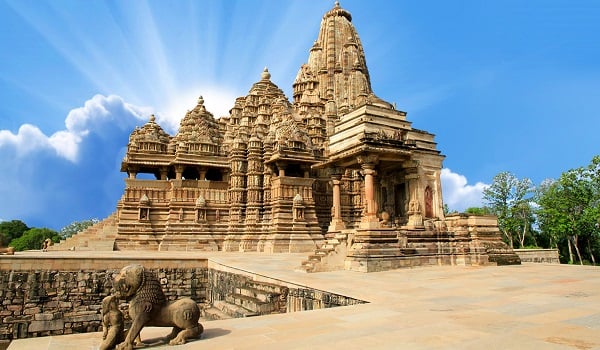
An Overview of Temples
The name Khajuraho is derived from its Sanskrit nomenclature ‘Kharjuravahaka’ which is the confluence of two Sanskrit words ‘Kharjur’ meaning date palm and ‘Vahaka’ meaning bearer. There are about 25 temples spread over an area of approximately 6 square Km. The temples are grouped into three categories depending on their orientation – the Western Group of Temples, the Eastern Group of Temples and the Southern Group of Temples. These temples are dedicated to several Hindu Gods and Goddesses along with deities in Jain beliefs. Among the temples that are standing till now, 6 are dedicated to Lord Shiva, 8 to Lord Vishnu, 1 each to Lord Ganesha and the Sun God, while 3 are dedicated to Jain Tirthankaras. The largest of the temples is the Kandariya Mahadeo Temple that is dedicated to the glory of lord Shiva. It makes Khajuraho one of the four holy sites dedicated to the glory of Lord Shiva, the other three being Gaya, Kashi and Kedarnath.
The temples are known for their elaborate and intricate carvings and sculpture. While these sculptures depict various scenes from everyday lives, the Khajuraho temples are primarily known for the artful and erotic depiction of the female form as well as various sexual practices of the time.
The four Jain temples are primarily located among the eastern group of temples. The Parasvanath, Adinath, Shantinath and Ghantai temples are the ones dedicated to worshipping of the Jain Trithankaras. These temples were constructed by the Chandela rulers in deference to the flourishing practice of Jainism in central India during their rule.
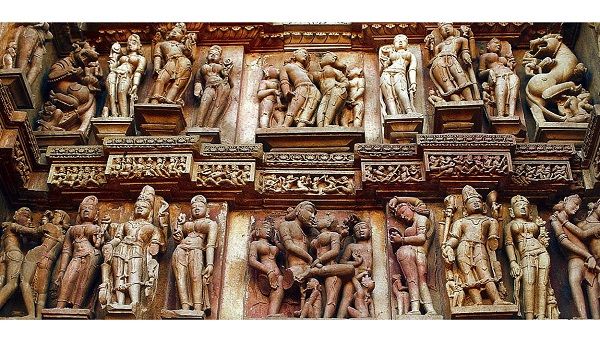
History
The temples of Khajuraho were commissioned by the Rajput rulers of Chandella Dynasty who ruled over central India from the 10th to the 13th Century CE. The temples were built over a period of 100 years and it is believed that each Chandela ruler commissioned at least one temple in the complex during his lifetime. The temples were built about 57 Km from the city of Mahoba, the capital of the Chandela dynasty rulers. Most of the present-day surviving temples were built during the reigns of king Yashovarman and Dhangadeva. Historical accounts of Abu Rihan-al-Biruni describe the temple complex of Khajuraho from towards the end of 11th century, when Mahmud of Ghazi attacked Kalinjar. The Kings struck a deal with Mahmud by paying a ransom that prevented him from looting the temples.
Throughout the 12th century, the temple complex grew and actively tended to till the downfall of the Chandela Dyanasty at the hands of the Sultan of Delhi, Qutb-ud-din Aibak. During the subsequent centuries, the region was largely controlled by Muslim rulers. Some temples were desecrated by the Muslim conquerors but the temples of Khajuraho were left largely neglected owing to their remote location.
In 1830, the British surveyor, T.S. Burt rediscovered the temples and efforts were made towards their excavation and restoration.
Accounts of foreign travellers like Ibn Batutta and archaeologists like Alexander Cunningham presented the great artistic character of the temples to the world making it one of the most visited tourist attractions in India.
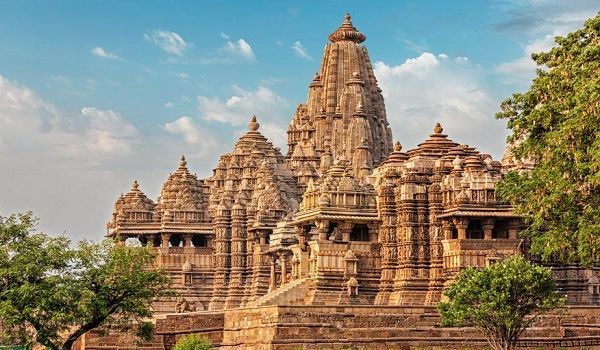
Construction
The Kalinjar region of Bundelkhand is home to superior quality sandstone that was primarily used as building material for the Khajuraho temples except the Chusat Yogini temple which is completely made of granite. The foundations of the temples were made of granite but are mostly hidden from the view. Stonemasons used the mortise and tenon joints to put the blocks of stones together which were then held in place by gravity. The columns and epistyles were built from single monoliths to afford maximum stability. The sculptures were done on sandstones that allowed very precise carving, resulting in production of fine details with ease.
The Chausat Yogini temple was the first of the temples to be built among the temples still standing; it was built around late 9th century. Yashovarman, also known as Lakshmanvarman, ruled between 925 and 950 CE and commissioned the famous Lakshman Temple. King Dhangadeva, son of Lakshmanvarman, commissioned the two most well-known Shiva temples, the Vishwanath Temple and the Vidyanath Temple. He also commissioned the Parasvanath Temple for the Jain worshippers. The largest of the temples in Khajuraho is the Kandariya Mahadeva Temple built during the rule of King Gandadeva between 1017 and 1029 CE. Other smaller temples like the Jagadambi, Chaturbhuj. Dulhadeo etc. had maintained the same level of artistic details in the carvings as the bigger temples. Only exceptions are the Javari and the Brahma temples, which are devoid of such elaborate adornments.
The temples are clustered near water bodies, as is traditional for most Hindu temples. The complex originally had around 64 water bodies, 56 out of which have been identified by archeologists during various excavations. Currently three water bodies including a river are part of the complex - Sib Sagar, Khajur Sagar or Ninora Tal and Khudar Nadi.
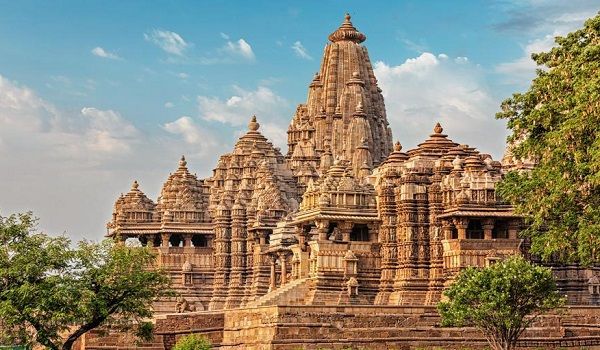
Architecture of Temples
The temples are grouped according to their location within the complex into three clusters.
First is the western group of temples comprising of the Lakshmana Temple, Kandariya Mahadeo Temple, Devi Jagadambi Temple, Chausat Yogini Temple, Chitragupta Temple, Matangeshwara Temple, Varaha Temple and Vishwanath Temple.
The Eastern Group of Temples includes the Parasvanath Temple, Ghantai Temple, Adinath Temple, Hanuman Temple, Brahma Temple, Vamana Temple and Javari Temple.
The third and comparatively smaller group of temples id the Southern Temples Group include the Dulhadev Temple, Beejamandal Temple and Chaturbhuj or Jatkari Temple.
The design of the temples echo the Hindu mandala design principle of square and circles and laid out in a pentagon formed by convergence of three triangles, reciprocating the concept of ‘Panchbhut’ or five elements and ‘Trilokin’ or three realms. The principle of ‘Vastu-Purusha-Mandala’ is followed in the design of the temples. The Vastu or the structure in symmetrical, concentrically layered, and self-repeating design of the mandala is laid out encircling the Purusha or the deity in the central inner sanctum. The temples consists of several repetitive architectural elements that are listed below –
Adhishsthana or the Base Platform – generally made of a solid block of granite laid out to hold the structure’s weight and also accentuate the temples upward thrust.
Shringa or Central Tower – the whole temple structure is capped by an elevated structure that towers directly over the site where the deity is placed inside.
Urushringa or Secondary Tower –the Shringa is often surrounded by smaller similarly designed towers around it known as Urushringa. These help in emphasizing the height of the structure.
The shringa is often topped with a stone disk with ridges on the sides known as the amalaka which in turn is crowned with a kalasha or the finial from where the banner is flown. The amalaka represents the sun. The entrance porch or the Ardhamandapa leads to the main hall of the temple or the Mandapa and in case of bigger temples it leads to the Mahamandapa or the Great Hall. Elaborate pillars generally adorn the Mahamandapa with carving and sculptures. From the hall there is usually an ambulatory space on both sides surrounding the Inner Sanctum or the Garbhagriha where the temples’ primary deity is situated. These ambulatory spaces allow devotees to perform the ritual circumambulation of the deity in clockwise direction known as Pradakshina. The temple’s Garbhagriha contains either stone sculpture or relief or image of the deity. The word ‘garbha’ refers to womb and the inner sanctum represents all the things that it stands for – potential, secret, and a space for development. The deity is place directly below the highest point of the structure.
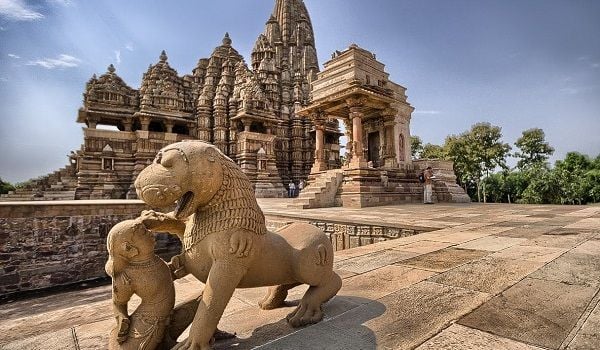
Art and sculpture
The main attraction of the Khajuraho temples is the beautifully intricate carvings and sculptures that adorn the temples’ outer walls. These sculptures were often inspired by religious sensibilities of the kings or may be from various Vedic literatures and even from the traditional lifestyle in the day-to-day life. The sculptures are curved in strict accordance with the Shilpashastra that governed the various aspects of correct depiction of a deity or female forms. The sculptures display various levels of perfection and artfulness.
The temples of Parasvanatha, Vishwanatha and Lakshmana display sculptures in most classical forms that follow the dictated guidelines of proportions and adornments. From there, a gradual increase in artistic touch is evident in the sculptures of the Citragupta and Jagadambi temples.
The beauty and elegance of the sculptures reach their zenith in the Kandariya Mahadeo temple, where the human form attains perfect physiognomy. The figures here attain distinctively slender forms with a wide variety among elegantly posing Apsara figures. This sculpture style is evident in the Vamana and Adinatha temples as well.
The decline in the refinement of the art form is evident from the sculptures of Javari and Chaturbhuja temples. The figures appear lifeless and conventionalized.
The scene gets slightly better in Dulhadeo with a combination of dynamic yet romantic forms depicting elaborate ornaments.
The general theme running through the sculptural carvings are examples from the four necessary pursuits of life which are Artha, Kama, Dharma and Moksha. About 10% of the total sculptures in Khajuraho depict erotic and explicit imagery which is the main attraction for people from all over the world. The Chandela rulers were believed to be followers of tantric practices which involved practicing of various sexual rituals. The sculptures depict men and women, together referred to as Mithunas, engaged in various forms of sexual acts according to the descriptions provided in the Kamasutra.
Other sculptures depict scenes from various stages of human life as well as various day-to-day activities performed by men and women. Considering the positioning and proportion of erotic sculpture among others, a natural philosophical conclusion may be drawn. One must go through the various worldly pursuits like physical pursuits or Kaam before they can get jaded of them and are ready to join the quest of true knowledge or Gyan. As a powerful symbolism, these erotic sculptures are placed mostly on the outer walls of the temples which imply that one must leave all erotic thoughts outside before entering the statuary of God.



